Selection and operation of potato diggers for a walk-behind tractor
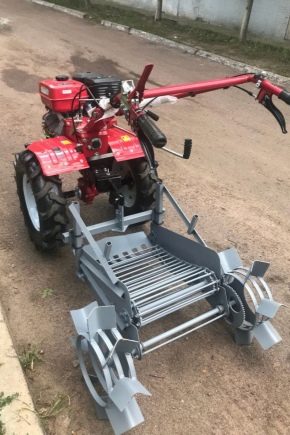
Landowners are quite willing to use mechanized helpers for cultivating the land and harvesting. A few years ago, potatoes were harvested only by hand; special devices were found only in large agricultural state corporations. Nowadays, potato diggers are available even to the smallest farmer.

Design features
As soon as the spring sowing season, as well as the work on digging the ground and applying fertilizers, ends, an equally troublesome period of complex crop care begins. But even with the onset of autumn, the life of a farmer does not become easier - after all, he is faced with the difficult task of harvesting. Especially a lot of time and effort is spent on harvesting potatoes.
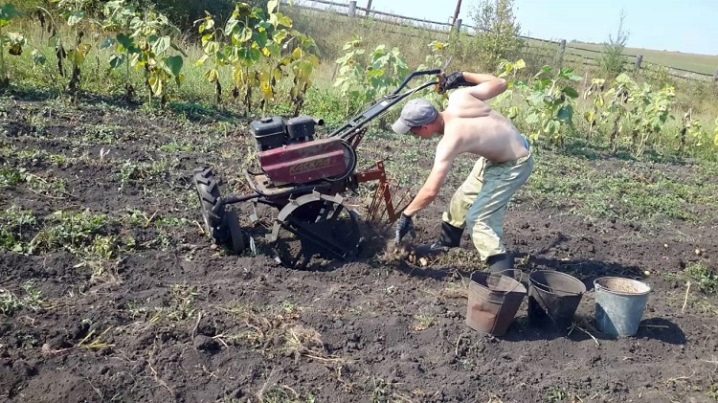
Of course, you can also dig up root crops manually, but it is quite difficult to cope with this alone, in most cases you have to attract helpers, whose services must be paid for. If the potatoes are grown for sale, then such an expense item can seriously curtail the profit received, or even completely negate all long efforts to grow root crops.

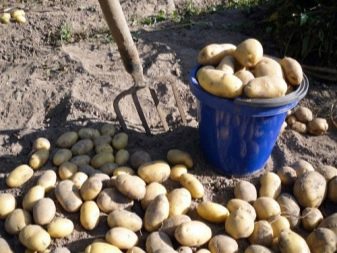
In addition, manual work takes a long period, which is highly undesirable. It is in this case the best way out can be a potato digger, this device was invented quite a long time ago.
Thanks to such a device, the harvesting speed and labor costs are significantly reduced, and the effectiveness, on the contrary, increases.
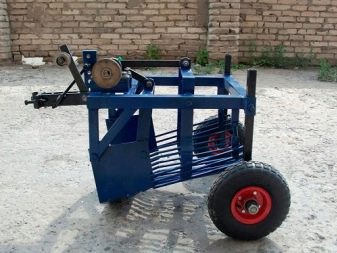

How does it work?
A special formwork for a walk-behind tractor, designed for collecting potatoes, can be bought ready-made in a store, but many craftsmen prefer to make it with their own hands. This device is classified as an attachment that is attached directly to the machine using a special hitch. The structure lifts the soil layer and digs out the root crops, which can then be harvested by hand from the surface of the earth. Compared to manually digging up potatoes, this method saves a lot of time. The average labor productivity of diggers is 0.1-0.02 hectares per hour, this parameter is several times higher than the promotional indicator for manual assembly.

The potato digger can also be used for all other root crops - carrots, as well as beets, turnips, radishes and onions. Nevertheless, before you buy such a necessary mechanism, try to make sure that you can hook it on your walk-behind tractor or cultivator. It is imperative to take into account the power characteristics of this walk-behind tractor, as well as the characteristics of the soil in which the crops are grown.
Keep in mind that a digger is quite expensive, so when choosing a model, it is worth taking into account all the parameters listed, otherwise you risk simply wasting your money.

Views
Depending on the design features, there are drum-type diggers, fan-type, rotary diggers, cardan-driven mechanisms, with a power take-off shaft and gearboxes.
According to the principle of operation, potato diggers are divided into three types:
- roaring;
- simple;
- conveyor.
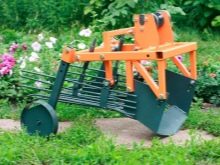


Rumbling or vibrating
The vibratory digger is considered the most efficient in comparison with all other types of equipment. It consists of a special grid table as well as a drive and a share.The principle of operation is quite simple: one of the main elements of a potato digger is flat bread, which goes deep into the ground and, together with the potatoes, picks up the upper layers of the earth, which are transferred to the table grate. After that, under the influence of a slight vibration, the excess earth begins to flake off and "go" through the cracks back into the ground, and the roots themselves, already peeled, fall out from the back of the unit.
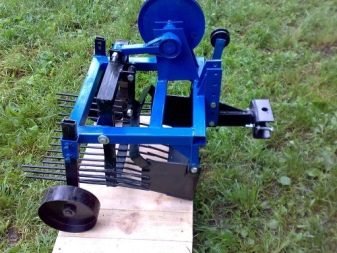
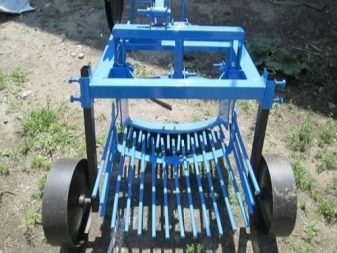
This system allows you to collect up to 98% of all tubers from the ground. The mower knives are buried 21-25 cm in the ground and grasp a layer of soil 35-40 cm wide, thanks to this mechanism, a fairly significant area of plantings can be processed at once. The screen type model successfully copes even with heavy soils, after digging, absolutely all the tubers remain lying on the ground, so the farmer does not have to dig into the clods and look for the tubers remaining there.
When using a vibrating potato digger, almost all tubers are dug out and at the same time whole.

However, there were some drawbacks. The cost of such a digger is very high, in addition, it is unprofitable to use it in small areas, since the costs of purchasing it and fuel consumption simply will not pay off. Also, vibration is often transmitted from the mower to the walk-behind tractor, and from there to the operator, which can cause some discomfort for the operator.
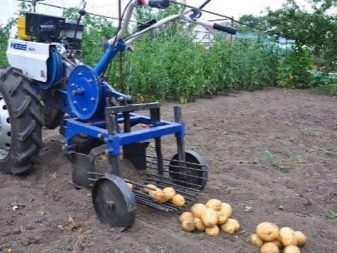
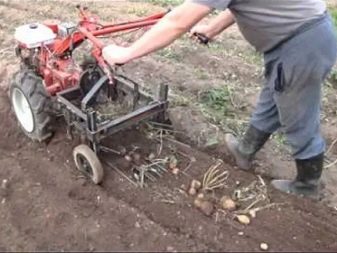
Simple or lancet
The simplest version of the potato digger is considered to be a universal lancet. It is a mechanism that visually resembles a shovel, to which rods are attached. Due to the sharpened edge, the device undermines the soil in the aisles, and the potatoes fall on the teeth of the device. After that, all unnecessary soil crumbles, and the potatoes are thrown onto the surface of the sown area.
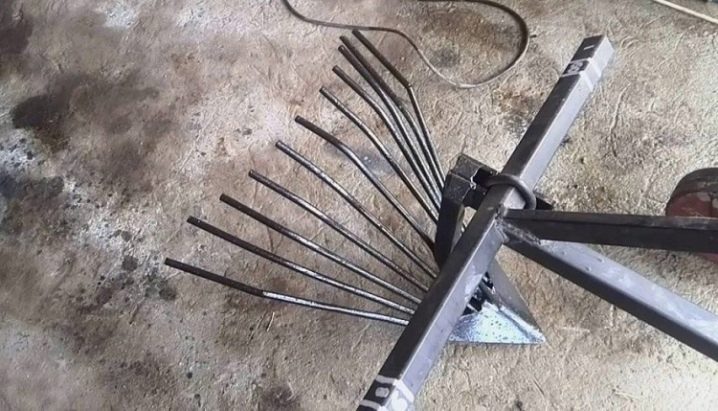
This scheme has many advantages:
- the device is universal, therefore it can be mounted to a wide variety of modifications of walk-behind tractors;
- the digger can be used even with low-power walk-behind tractors;
- several varieties of universal devices are presented on the modern market, which allows the farmer to choose the best option based on the structure and moisture of the soil, as well as the depth of placement of potatoes;
- increased speed and performance of the unit, by connecting such a digger to a walk-behind tractor, it can even be turned on in second or third gear;
- a universal modification is relatively inexpensive and therefore available to most of Russian summer residents and owners of household plots.
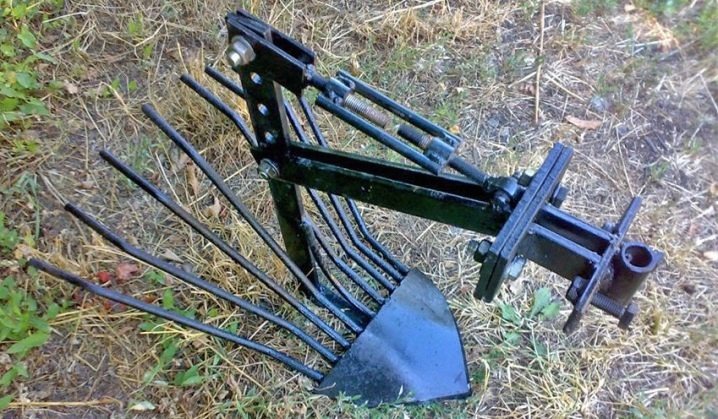
The universal model also has its drawbacks:
- the digger is buried no more than 15 cm into the ground, and its width does not exceed 20 cm;
- after harvesting, at least 15-20% of all potatoes remain in the ground;
- the sharp edges of the shovel often cut the tubers during their digging, however, with the manual method of assembly, this figure is much higher;
- the crop can only be harvested in rows - before you start digging out the potatoes, you must definitely dig up the previous row.
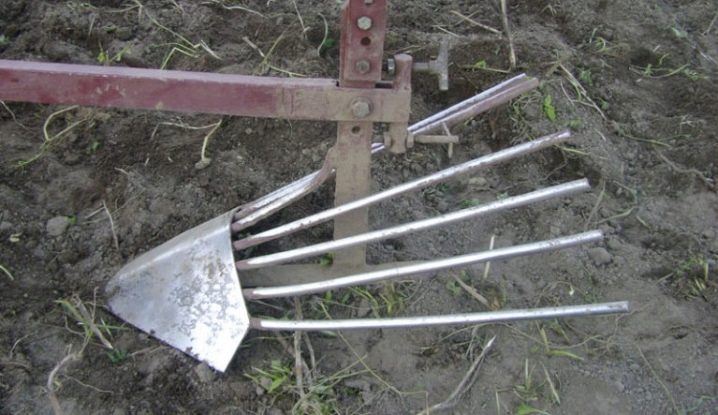
Conveyor
Potato digger designed for heavy draft motoblocks. The only drawback of such equipment is its very high cost. The unit with a belt mechanism is a bit like a vibrational type of devices, however, instead of a special table, there is a moving belt. During the operation of the unit, the tubers move along it and undergo a complete cleaning of soil residues. This model is optimal for large farms that grow large quantities of root crops for commercial purposes. The harvest with such a digger can be collected quite quickly, even on a large sown area.
Please note that before starting the harvesting system, you should check the area for thickened weeds, as if not removed, they can wrap around the mechanism.
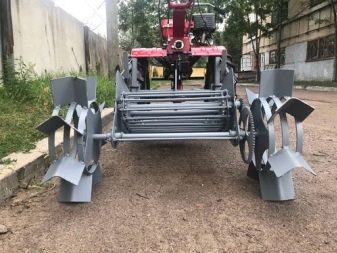

Model rating
Modern industry produces several types of potato diggers.Consider the most effective and reliable according to experts.
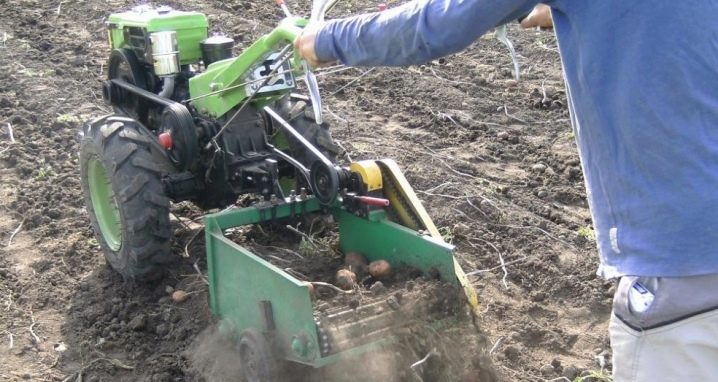
KKM-1
This is a vibratory model that is optimal for processing areas with light soils and moisture content not exceeding 27%. In addition to potatoes, such a unit can collect other root crops, for example, carrots, beets, onions and others. The weight of the device is 40 kg, the width of the ground coverage is 37 cm and the plowing depth is 20 cm. The model has a high productivity - 0.2 hectares / hour, as a rule, the device is implemented in a set with a sieve grate, as well as a ploughshare. It is designed to work with "Agat", "MTZ", "Kaskad", "Neva", "Favorit" and "Salut" walk-behind tractors.


KV M-3
This is an attached agricultural equipment of a screening type, which can interact with absolutely different types of motoblocks of domestic, Ukrainian and Chinese production. Most often it is used together with units of the Zarya, Salyut, Agat and Neva brands. The mechanism can work on hard and difficult soils - for this it is equipped with special cutters that create more tangible vibrations of the grating shaking the ground. The mass of KVM 3 is 39 kg, the operating speed is 1-2 km / h. Capture parameters are: width - 37 cm, and depth - 20 cm. Productivity - 0.1-0.2 hectares / hour.
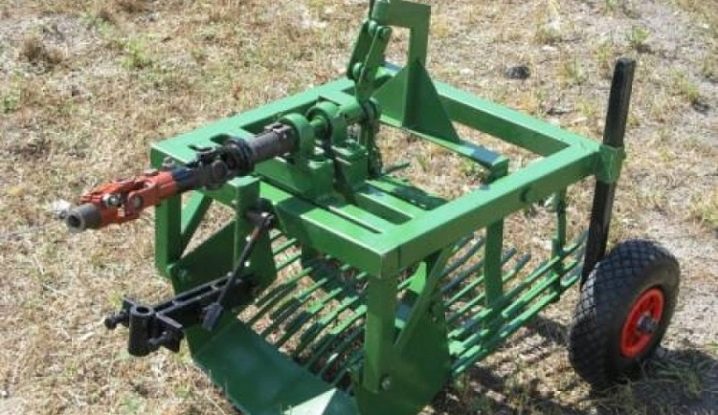
Poltavchanka
This is another representative of vibration-type devices, which is optimal for processing small plots of land, the area of which is not more than 2 hectares, the weight of the equipment is 35 kg, the performance parameters correspond to 0.2 hectares / hour, and the operating speed is about 2-3 km / h. ... With this potato digger, you can process a strip up to 39 cm wide at a depth of 18 cm at a time.
The modification includes a pin, as well as a belt, thanks to which the system is securely attached to walk-behind tractors manufactured by Zarya, MTZ, Agat and many other domestic installations. This attachment is perfect for harvesting in medium-heavy soils with a moisture content of up to 30%. Due to the option of adjusting the parameters of the wheels, you can change the depth of the ground during harvesting.

CT-51
The capture width of such a unit corresponds to 45 cm, the weight of the device is 47 kg. The model adjusts the depth of the ground grasp using support wheels. The function of adjusting the conveyor speed is possible, which is carried out through the rotation of the walk-behind tractor. The model is optimal for heavy motoblocks, for example, such as "Zubr" or "Centaur".
The only drawback is that the unit is quite expensive.
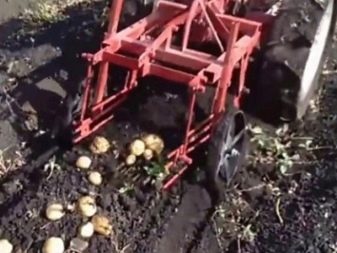
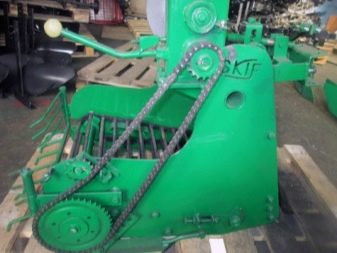
KM-2
This is a model of single-row potato diggers that allow you to harvest root crops without damaging the tubers. Usually the mechanism is used to work in small areas. Thanks to the operation of the device, the tubers are quickly separated from the soil, and not a single one is left missing. The main advantage of such models is the availability of spare parts that can be bought at any garden equipment hypermarket. The device works on all types of soil. The wheel attachment with a bracket is located at the base of the machine, which allows you to adjust the plowing depth.
Today, in Russian stores you can buy a wide variety of products, the cost of which starts from 6 thousand, and a wide assortment line of equipment with a very different technical and operational parameters is on sale, so everyone can choose a model based on the load intensity, the size of the sowing space and type of soil.
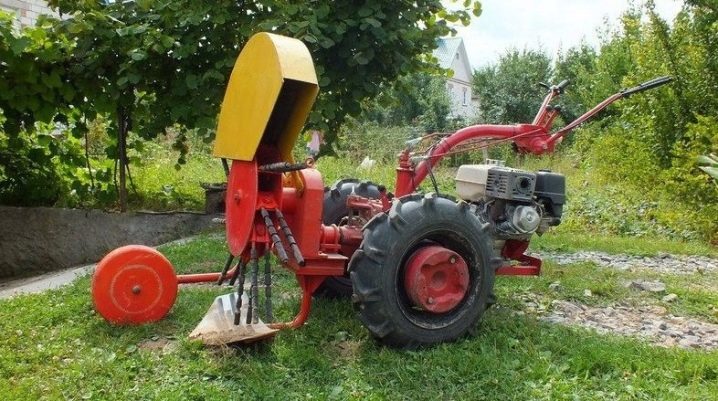
How to install and configure?
To attach the potato digger to the walk-behind tractor, use a hitch, which includes the front part - it is attached to the tractor, a device for adjusting the incline of attack, as well as a bracket for fasteners. The hitch is divided into two elements. The right one remains on the digger, and the second is fixed to the tractor, both parts are connected with special bolts. A long center screw is used to adjust the mechanism.How you set it up will determine the depth of digging the earth when the device is operating.
It should be tightened with a wrench and select the optimal position, then fasten the drive belt and pass it exactly over the tension roller.
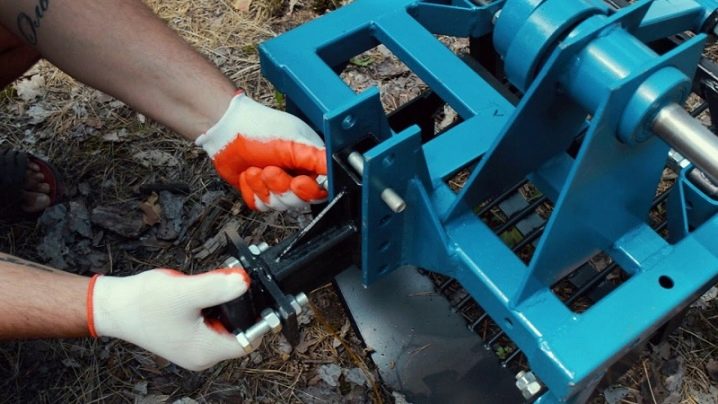
After starting the engine, the potato digger immediately starts to work, however, it often happens that the hitch begins to enter the ground at the wrong angle, the reason is the wrong setting of the mechanism. If the situation is not corrected, then the walk-behind tractor will begin to slip or the belt will simply slip off the pulleys. As a result, the conveyor of the mechanism will become clogged with earth, and it will be impossible to continue working.
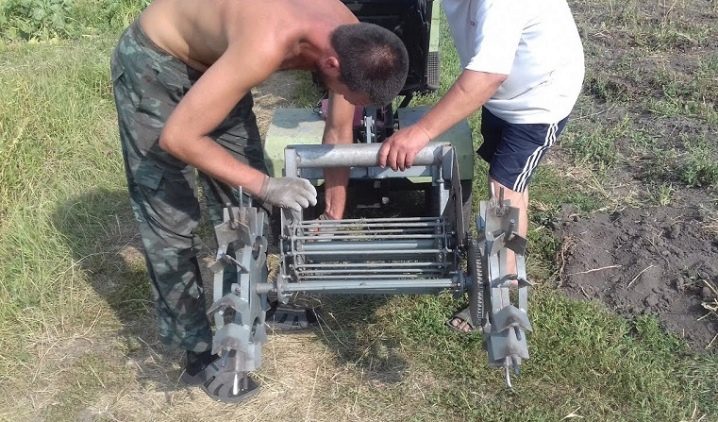
In this case, adjust the settings; for this, carefully rotate the angle of attack screw so as to decrease it. In addition, on the trailing knot, you need to choose the optimal position for the holes, thanks to such actions, you can set the desired depth of immersion in the ground. In order for the digger to interact correctly with the walk-behind tractor, all existing bolts on the trailed unit should be adjusted, in this case, the units will be located on the same axis, and the device itself will move evenly along the surface and will not begin to go too deep into the ground.
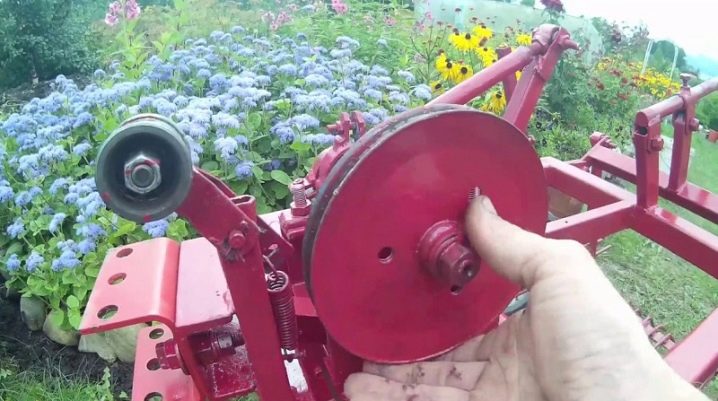
Many craftsmen prefer to make a potato digger with their own hands. - such equipment comes out much cheaper, and it works quite well. Having the most minimal skills in working with metal objects, as well as diagrams and drawings, the excavator can be built in just a few hours. The manufacture of a mechanism usually begins with the manufacture of a welded frame, for this you need a square pipe made of metal, it is sawn into 4 segments of the selected length, a rectangle is welded from them, then a jumper is made from the remains.
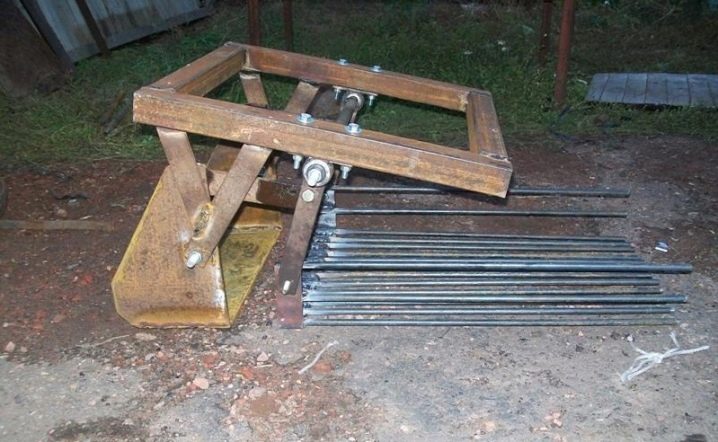
At the next stage, it is necessary to make vertical posts, usually they are cut from metal squares, and then welded to a steel frame, the posts are fixed together with iron rods, usually their diameter is 0.5 cm.The cutting part of the device, which will be directly responsible for cutting the ground, made from steel sheet 5 mm thick or from an old circular saw, in both cases such a potato digger will work very well. At the same time, the sharpening must be rounded, thanks to this it will not be able to go too deep into the ground and will minimize the likelihood of damage to the tubers themselves.
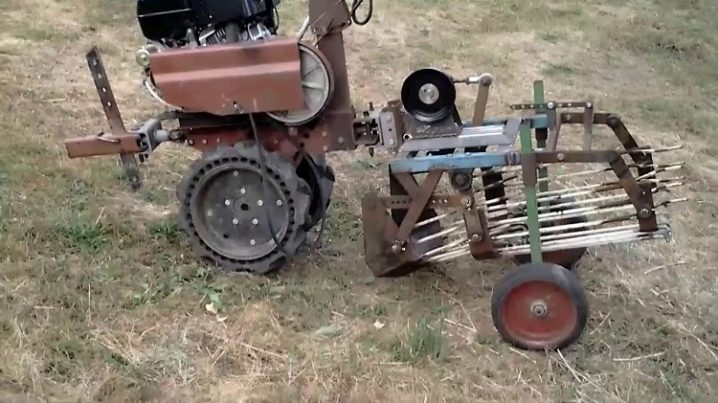
Homemade construction, as a rule, is supplemented with movable wheels, usually borrowed from an old garden cart, it is best to pay attention to devices with wide tires - they will make moving along the beds easier. It is optimal if the wheels are equipped with an axle to which the racks with selected holes will be attached. If you do not have suitable wheels, you can use metal ones.
This will make the structure heavier, but the machine will work more efficiently on hard soils.
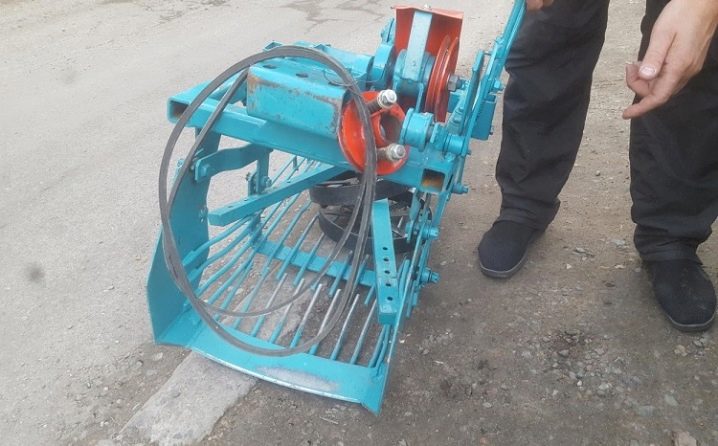
If you are going to work with wet soils, then it would be correct to give preference to rubber wheels, but with a tractor tread. Keep in mind that normal rubber wheels will move much worse in wet ground. All elements are connected to each other using resistance welding, as well as using traditional fasteners - nuts and bolts. The first option is more practical and durable, but the models made according to the second principle can be disassembled and reassembled if necessary. It is not difficult to assemble a digger, while the cost of the finished product will be minimal.
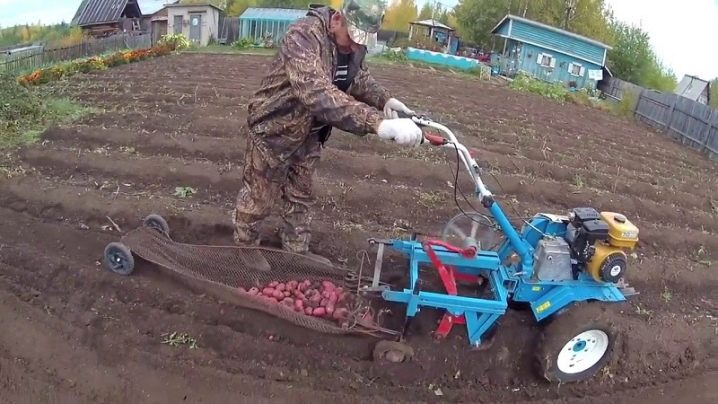
For information on how to set up and adjust a potato digger with a walk-behind tractor, see the video below.



































































The comment was sent successfully.